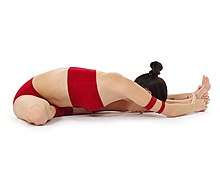Janusirsasana
Janu Sirsasana (Sanskrit: जानु शीर्षासन; IAST: jānu śīrṣāsana), Head-to-Knee Pose,[1] is a seated twisting and forward bending asana in diverse schools of modern yoga as exercise.

Etymology and origins
The name comes from the Sanskrit words janu (जानु, jānu) meaning "knee", shirsha (शीर्ष, śīrṣa) meaning "head", and āsana (आसन) meaning "posture" or "seat".[1]
The pose is a modern one, first seen in the 20th century.[2] It is described in Krishnamacharya's 1934 Yoga Makaranda,[2][3] and in the works of his pupils, B. K. S. Iyengar's 1966 Light on Yoga[4] and Pattabhi Jois's Ashtanga Vinyasa Yoga.[2][1]
Description
In a seated position, one leg is extended with toes pointing upward, and the other leg is bent with knee pointing away from the straight leg and the sole of the foot in by the groin. The torso turns and folds over the extended leg.[4][5]
See also
- Paschimottanasana, a seated forward bend that does not involve twisting
References
- "Janu Shirshasana A". Ashtanga Yoga. Retrieved 2011-04-09.
- Sjoman, Norman E. (1999) [1996]. The Yoga Tradition of the Mysore Palace. Abhinav Publications. pp. 88, 100, 102. ISBN 81-7017-389-2.
- Krishnamacharya, Tirunamalai (2006) [1934]. Yoga Makaranda. Translated by Lakshmi Ranganathan; Nandini Ranganathan. pp. 77–83.
- Iyengar, B. K. S. (1979) [1966]. Light on Yoga: Yoga Dipika. Unwin Paperbacks. pp. 148–151. ISBN 978-1855381667.
- Saraswati, Swami Satyananda (2003). Asana Pranayama Mudra Bandha. Nesma Books India. pp. 235–236. ISBN 978-81-86336-14-4.
_from_Jogapradipika_1830_(detail).jpg)
